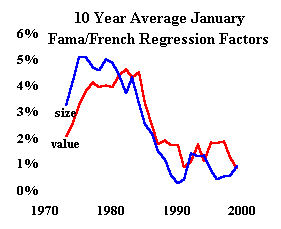Efficient Frontier

William J. Bernstein
Efficient Frontier

William J. Bernstein
![]()
The Incredible Shrinking January Effect
One of the most hallowed tenets of domestic asset class theory is the January small cap effect ("JE"). To wit:
- Small company stocks, because of their higher risks, have a higher return than large company stocks.
- For some bizarre reason all of this excess return occurs in January.
For example, if one divides domestic stocks into NYSE size deciles, and then measures the 1926-94 excess return over the largest (1st) decile, it turns out that the January excess is actually larger than for the entire year for the smallest stocks:
Return in Excess of 1st Decile
Decile
January
Whole Year
2
1.10%
1.49%
3
1.47%
2.04%
4
1.76%
2.33%
5
2.84%
3.14%
6
3.29%
3.06%
7
3.86%
3.24%
8
5.20%
3.86%
9
6.86%
4.54%
10
10.28%
7.82%
(Source: Stocks, Bonds, Bills, and Inflation, 1995 Yearbook, Ibbotson)
The precise reason for this anomaly is best left for another day, but there is no shortage of candidates. End-of-year tax loss selling is my favorite, but there are no easy answers.
Entire "how to" books have been devoted to the "Incredible January Effect," and it's also a perennial late-year topic for material-starved financial writers, the most recent being a piece in the New York Times by none other than Mark Hulbert.
Unfortunately, there are two fundamental problems with the JE. First, the astute reader will note that its magnitude is roughly equivalent to the bid-ask spread for each decile. In other words, the simple act of buying and selling small stocks eliminates the benefit.
Second, it no longer exists. Below is a graph of the 10 year rolling average of the small cap premium, calculated as the difference between the January return of the CRSP 9-10 index and the S&P 500:
When I brought this to Mr. Hulbert's attention, an assistant, Mr. Paul Bolognese, replied:
It is true that, at least by some measures, the January Effect has been smaller in recent years. Yet by other measures it is just as great. For example, among small-cap stocks with the highest book-to-market ratios, the JE seems to be just as robust.
It may also be that the Ibbotson data for small-cap performance are guilty of survivorship bias for the years prior to the early 1980s, which is when their data started reporting the real-world performance of DFA's 9-10 Small Comparny fund.
In other words, not only might the January effect be an artifact of survivorship bias (which may also be true of the entire small cap premium), but it's really not a small-cap effect. It's a value effect.
OK, that's a testable hypothesis. Below is a graph of the 10 year rolling averages for the size ("SmB") and value ("HmL") Fama/French regression factors for January starting 1964:

You can approximate the January excess return for small value stocks simply by adding the two plots together. Again, bye-bye JE. (Note that the value excess return is still quite robust, it's just not all that prominent in January.)
If the JE has gone the way of disco and nonstop flights to your destination, then why do folks still write about it? I can't answer that one in polite fashion, so I won't. But one thing is clear. It's time that financial journalists let this one go.